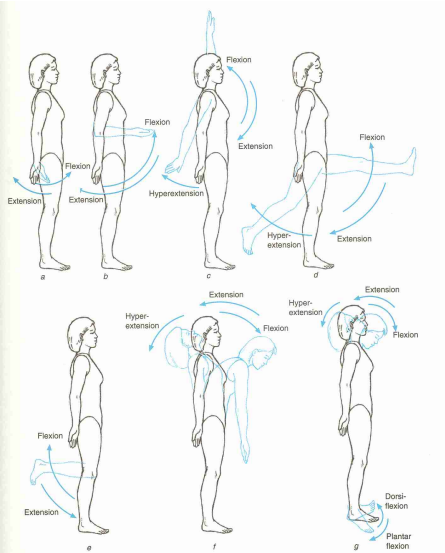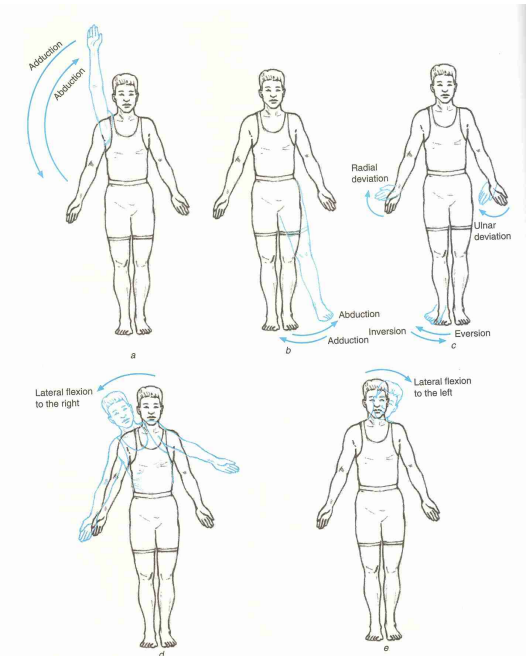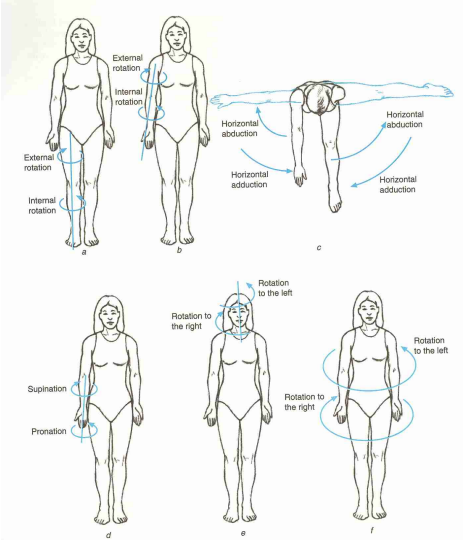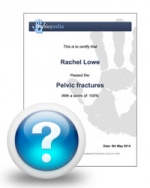Cardinal Planes and Axes of Movement
Original Editor - The Open Physio project
Top Contributors - Admin, Rachael Lowe, Kim Jackson, Lucinda hampton, Tarina van der Stockt, Simisola Ajeyalemi, Wanda van Niekerk, Laura Ritchie, Evan Thomas, Kai A. Sigel, Claire Knott, Jess Bell, Olajumoke Ogunleye, Tony Lowe and Scott Buxton
Summary[edit | edit source]
| Plane | Axis | Description |
| Sagittal / Antero-posterior | Coronal or Frontal, Lateral | Bisects the body from front to back, dividing it into left and right halves. Flexion and Extension movements usually occur in this plane. |
| Coronal / Frontal / Lateral | Sagittal or Antero-posterior | Bisects the body laterally from side to side, dividing it into front and back halves. Adbuction and Adduction movements occur in this plane. |
| Transverse / Horizontal | Vertical | Divides the body horizontally into Superior and Inferior halves. Rotational movements usually occur in this plane. |
General usage[edit | edit source]
| [1] |
Three basic reference planes are used in anatomy.
- A sagittal plane is a plane parallel to the sagittal suture and divides the body into sinister (left) and dexter (right) portions. The midsagittal or median plane is in the midline i.e. it would pass through the midline structures (e.g. navel or spine), and all other sagittal planes (also referred to as parasagittal planes) are parallel to it. Median can also refer to the midsagittal plane of other structures, such as a digit.
- A coronal or frontal plane divides the body into dorsal (posterior or back) and ventral (anterior or front) portions.
- A transverse plane, also known as an axial plane or cross-section, divides the body into cranial (head) and caudal (tail) portions.
Note: for post-embryonic humans a coronal plane is vertical and a transverse plane is horizontal, but for embryos a coronal plane is horizontal and a transverse plane is vertical.
When describing anatomical motion, these planes describe the axis along which an action is performed. So by moving through the transverse plane, movement travels from head to toe. For example, if a person jumped directly up and then down, their body would be moving through the transverse plane in the coronal and sagittal planes.
A longitudinal plane is any plane perpendicular to the transverse plane. The coronal plane and the sagittal plane are examples of longitudinal planes.
Axis[edit | edit source]
An axis is a straight line around which an object rotates. Movement at the joint take place in a plane about an axis. There are three axis of rotation.
- Sagital axis - passes horizontally from posterior to anterior and is formed by the intersection of the sagital and transverse planes.
- Frontal axis - passes horizontally from left to right and is formed by the intersection of the frontal and transverse planes.
- Vertical axis - passes vertically from inferior to superior and is formed by the intersection of the sagital and frontal planes.
Usage in clinical situations[edit | edit source]
Sometimes the orientation of certain planes needs to be distinguished, for instance in medical imaging techniques such as sonography, CT scans, MRI scans or PET scans. One imagines a human in the anatomical position, and an X-Y-Z coordinate system with the X-axis going from front to back, the Y-axis going from left to right, and the Z-axis going from up to down. The X-axis axis is always forward (Tait-Bryan angles) and the right-hand rule applies.
- A transverse (also known as axial or horizontal) plane is an X-Y plane, parallel to the ground, which (in humans) separates the superior from the inferior, or put another way, the head from the feet.
- A coronal (also known as frontal) plane is an Y-Z plane, perpendicular to the ground, which (in humans) separates the anterior from the posterior, the front from the back, the ventral from the dorsal.
- A sagittal (also known as median) plane is an X-Z plane, perpendicular to the ground, which separates left from right. The midsagittal plane is the specific sagittal plane that is exactly in the middle of the body.
The axes and the sagittal plane are the same for bipeds and quadrupeds, but the orientation of the coronal and transverse planes switch. The axes on particular pieces of equipment may or may not correspond to axes of the body, especially since the body and the equipment may be in different relative orientations.
Movements[edit | edit source]
Extension occurs when the angle between two adjacent segments in the body increases as the ventral surfaces of the segments move away from each other and occurs in a sagittal plan about a frontal axis. An exception is extension of the thumb, which takes place in a frontal plane about a sagittal axis.
Flexion occurs when the angle between two adjacent segments in the body decreases as the ventral surfaces of the segments approximate each other and occurs in a sagittal plane about a frontal axis. An exception is flexion of the thumb, which takes place in a frontal plane about a sagittal axis.
Abduction/Adduction These are movements in the frontal plane about the sagital axis and involve moving the body part away or towards an imaginary centre line. Abduction is taking the body part away from the central line and adduction is moving it towards. Adduction can also be moving the body part across the centre line and to the other side of the body, shown in the hip abduction video below. Amongst the joints capable of abduction and adduction are the shoulder and hip. Other abduction and adduction movements include the fingers. If you splay your fingers and move them apart, this is abduction as they are moving away from the centre position. When you bring the fingers back together, this is adduction, as you are adding them back to the centre line
Rotation Rotation movements are in the transverse plane and include any twisting motion. Joints which permit rotation include the shoulder and hip. These are both ball and socket joints. We can also rotate our necks and backs due to a series of smaller joints, including the atlanto-axial joint which is a pivot joint in the neck between the first two vertebrae (C1 and C2).
Rotation of the hip and shoulder can be broken down into internal or external rotation (also sometimes known as medial and lateral rotation respectively). In the example of the shoulder video below, internal rotation is the movement of the hand either inwards towards the body (when the shoulder is adducted) or down to point towards the floor (when the shoulder is abducted). External rotation is therefore the opposite, when the hand moves away from the body (when the shoulder is adducted) or up towards the ceiling (when the shoulder is abducted).
Ranges of Movement[edit | edit source]
Hip[edit | edit source]
| Flexion | 0-125 |
| Extention | 0-15 |
| Adduction | 0-30 |
| Abduction | 0-45 |
| Internal Rotation | 0-40 |
| External Rotation | 0-45 |
Knee[edit | edit source]
| Flexion | 0-130 |
| Extension | 120-0 |
Ankle[edit | edit source]
| Plantarflexion | 0-50 |
| Dorsiflexion | 0-20 |
Foot[edit | edit source]
| Inversion | 0-35 |
| Eversion | 0-25 |
Metatarsophalangeal Joints of Foot[edit | edit source]
| Flexion | 0-30 |
| Extension | 0-80 |
Interphalangeal Joints of Toe[edit | edit source]
| Flexion | 0-50 |
| Extension | 50-0 |
Shoulder[edit | edit source]
| Flexion | 0-180 |
| Extension | 0-50 |
| Abduction | 0-180 |
| Adduction | 0-45 |
| Lateral Rotation | 0-90 |
| Medial Rotation | 0-90 |
Elbow[edit | edit source]
| Flexion | 0-160 |
| Extension | 0-145 |
| Pronation | 0-90 |
| Supination | 0-90 |
Wrist[edit | edit source]
| Flexion | 0-90 |
| Extension | 0-70 |
| Ulnar Deviation | 0-25 |
| Radial Deviation | 0-65 |
Metacarpophalangeal (MCP)[edit | edit source]
| Flexion | 0-90 |
| Extension | 0-30 |
| Adduction | 0-20 |
| Abduction | 0-25 |
Interphalangeal Proximal (PIP) Joints of Fingers[edit | edit source]
| Flexion | 0-120 |
| Extension | 0 |
Interphalangeal Distal (DIP) Joint of Fingers[edit | edit source]
| Flexion | 0-80 |
| Extension | 0 |
Metacarpophalangeal Joint of Thumb[edit | edit source]
| Flexion | 0-70 |
| Extension | 0 |
| Abduction | 0-50 |
| Adduction | 0 |
Interphalangeal Joint of Thumb[edit | edit source]
| Flexion | 0-90 |
| Extension | 0 |
Read 4 Credit[edit | edit source]
|
Would you like to earn certification to prove your knowledge on this topic? All you need to do is pass the quiz relating to this page in the Physiopedia member area. [Coming Soon] |
References[edit | edit source]
- ↑ Tim Huffines. Anatomical Position and Cardinal Planes. Available from: http://www.youtube.com/watch?v=aDxfe5Ny6zM [last accessed 22/02/13]










